In the spring of 1996, Pepsi debuted a hot new TV commercial.

It opens with a cocky teenager donning a Pepsi shirt. The text, “T-SHIRT 75 PEPSI POINTS,” appears to the beat of a military drum line.
Said teen then swaggers through a door in a leather jacket (“LEATHER JACKET 1,450 PEPSI POINTS”) and flips on a pair of blue-tinted sunglasses (“SHADES 175 PEPSI POINTS”).
The narrator chimes in — “The more Pepsi you drink, the more great stuff you’re gonna get!” — and the scene shifts to the teen landing a computer-generated Harrier fighter jet in front of his high school, blowing the clothes off a bewildered principal in the parking lot.
“HARRIER FIGHTER … 7,000,000 PEPSI POINTS” flashes across the screen as the music crescendos into a fade-out.
Via YouTube (nonfps)
The commercial was the national debut of a promotion called Pepsi Stuff.
It was, per The New York Times, the “largest promotional campaign in the company’s history” — one that Pepsi hoped would steal market share from Coca-Cola at the tail end of the decades-long Cola Wars.
In total, this promotion cost Pepsi an estimated $200m ($350m today) to roll out, including $125m worth of merchandise.
Pepsi Stuff worked like so:
- Billions of Pepsi products around the US were marked with “Pepsi Points.” A 2-liter bottle of Pepsi was worth 2 points; a 12-pack of cans yielded 5.
- Customers could save up the points and redeem them for items listed in a Pepsi Stuff catalog.
- Customers could also purchase Pepsi Points for 10 cents each.
The catalog included 53 items in total — most of which were your run-of-the-mill corporate swag: T-shirts, hats, and beach towels.
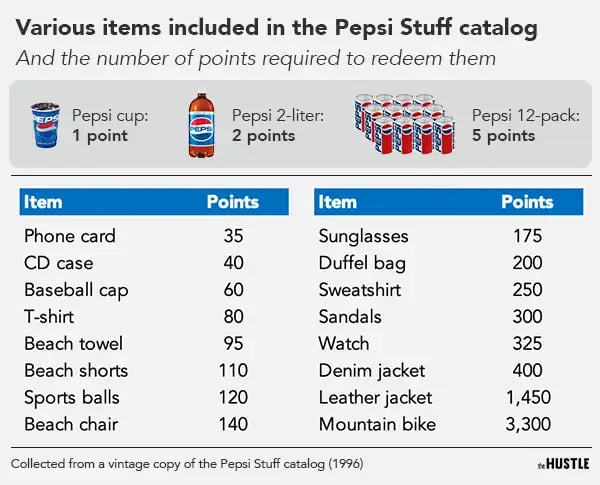
The Hustle
Notably absent from this list of items was the Harrier fighter jet.
Most of the kids who saw the commercial — members of the so-called “Pepsi Generation,” a new class of youthful consumers who cared more about lifestyle than brands — figured that the jet was part of Pepsi’s zany sense of humor and not a real prize.
But in Seattle, Washington, a young man named John Leonard wasn’t laughing.
I’ll take the jet
Leonard first saw the commercial during a Pacific Northwest test run in February of 1996.
Then a 21-year-old business student at Shoreline Community College, he saw the Harrier jet as a legitimate offer — and sniffed an opportunity for promotional arbitrage.
He knew, from an interest in flying, that the Harrier was a US Marine Corps aircraft used extensively in the Gulf War. Capable of taking off vertically and carrying 10k pounds of bombs, it had been called the “most captivating and the most dangerous plane in the US military.”
Moreover, it cost ~$33m to manufacture and — needless to say — wasn’t available to the general public.
At 7m Pepsi Points, the jet was a steal. So, he decided to go for it.
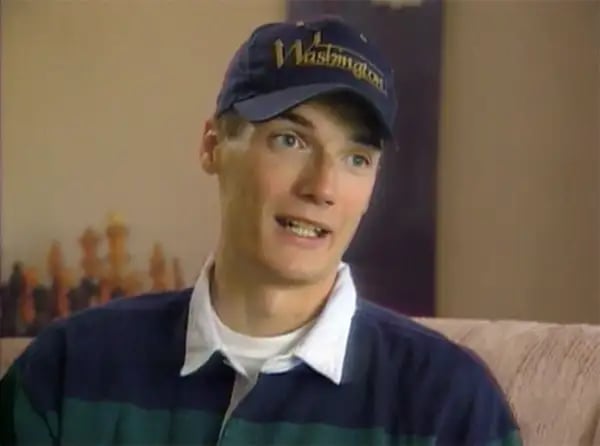
Leonard during a CBS interview in 1996 (CBS News, via YouTube)
Leonard was a 10-cans-per-day kind of guy.
But even at this high rate of consumption, collecting 7m points was a daunting task.
Each 12-pack of Pepsi was worth 5 points, meaning he’d have to consume 16.8m cans to reach his mark. That amounted to:
- 46k cans every day for 1 year
- 552k total ounces of Pepsi
- 2.5B calories and 689m grams of sugar
- ~$4m in expenditure
Luckily, there was a workaround.
The catalog only required participants to submit 15 points they’d collected from cans and bottles; the rest could be bought directly from Pepsi for 10 cents each by mailing in a check.
All Leonard had to do to get 7m points was raise $700k.
Over several months, the enterprising college student put together a business plan, researched case law on promotional advertisements, and convinced several investors — wealthy clients he’d met while working as a climbing guide — to front the cash.
On March 28, 1996, he mailed 15 Pepsi Points, along with a check for $700,008.50 (including shipping), to Pepsi and politely asked for his jet.
Several weeks later, Leonard received a reply from Pepsi.
The company returned Leonard’s check, threw in some pity coupons, and made it clear that the jet in the commercial was purely “fanciful.”
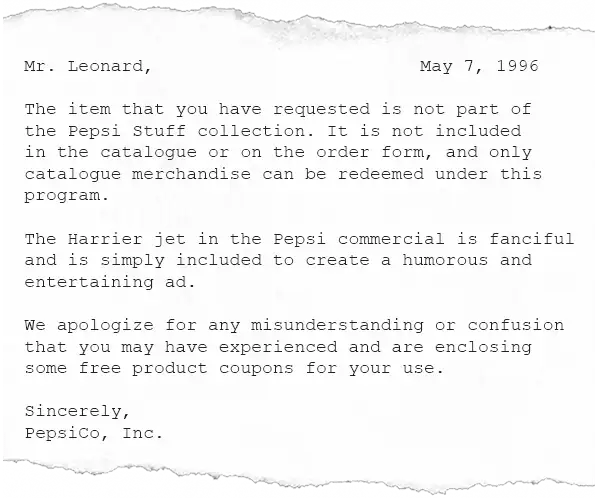
A mock-up of the response Leonard received from Pepsi corporate (legal proceedings, via Justia)
By this point, Leonard had already sunk ~$4k into consulting with legal professionals and researching case law on deceptive advertising.
Instead of backing down, he secured an attorney and doubled down on his demand:
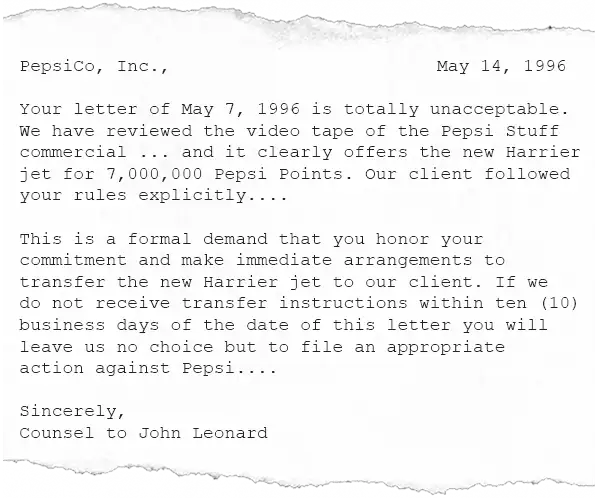
A mock-up of Leonard’s correspondence with Pepsi (legal proceedings, via Justia)
Leonard’s letter made the rounds at PepsiCo and eventually ended up in the hands of BBDO New York, the advertising firm Pepsi had retained to create the commercial.
A VP at the firm, Raymond E. McGovern Jr., seemed perplexed by Leonard’s persistence.
“I find it hard to believe that you are of the opinion that the Pepsi Stuff commercial really offers a new Harrier Jet,” he wrote back. “No reasonable person would agree with your analysis of the commercial.”
So, Leonard decided to go to battle for his fighter jet.
A battle in the courts
With the help of counsel, Leonard filed suit, claiming that Pepsi’s ad had constituted as a binding offer, and that the company had breached contract by refusing to exchange 7m Pepsi Points for a Harrier jet.
A flood of news reports followed the filing — and Pepsi made no qualms about publicly sharing its thoughts on the matter.
“Tens of millions of Americans, and people around the world, saw the spot, got the joke, and laughed,” a PepsiCo spokesman told CBS News. “Mr. Leonard saw the spot, hired business advisers and lawyers, and decided to take legal action.”
“I didn’t want any publicity on this,” Leonard retorted. “I’m not trying to make a statement. I’m not looking for a settlement. I just want a plane.”
In an interview with The Associated Press, he reiterated that he was “simply trying to take Pepsi up on an offer it made to the public.”
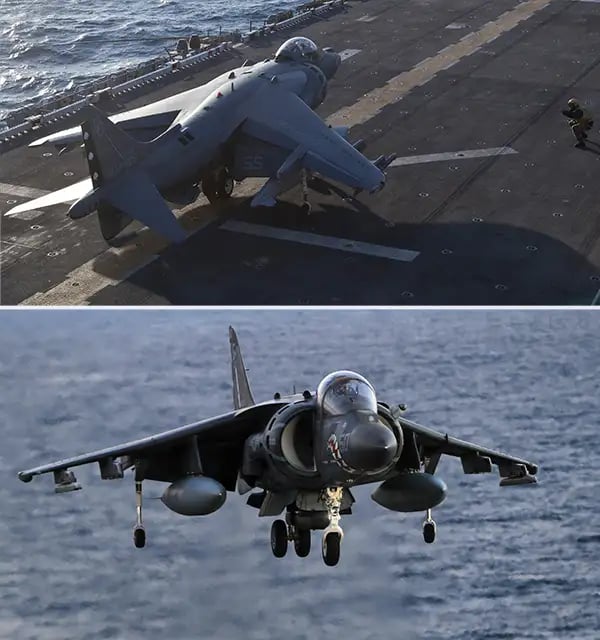
An AV-8B Harrier aircraft prepares for vertical takeoff near Catania, Italy. (Via Gisele Tellier/Getty Images)
PepsiCo, the parent company of Pepsi beverages, was swift to counterattack.
The conglomerate responded with its own suit in New York, seeking to recoup $88,162 in attorney’s fees and dismiss Leonard’s claims as frivolous without going to trial.
As things often play out in America’s justice system, the case turned into a 3-year-long procedural slog before making its way to Judge Kimba Wood of New York’s Southern District Court.
Ultimately, the case came down to whether Pepsi’s TV ad constituted a legally binding “offer.”
And on Aug. 5, 1999, Judge Wood ruled resoundingly in Pepsi’s favor.
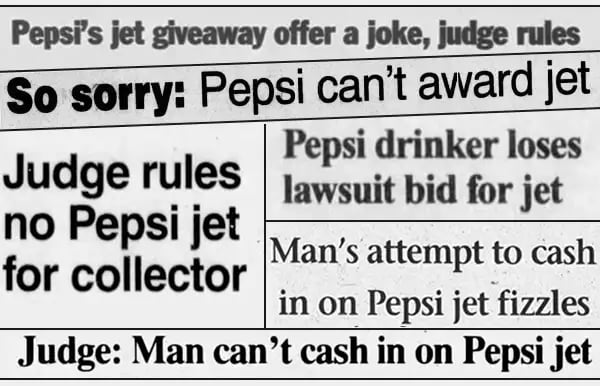
Newspapers around the country followed Leonard’s saga (various news sources; 1999)
The decision came down to 3 key points:
- Advertisements are generally not considered offers in contract law: “Ads for the sale of goods (TV, radio, newspaper, newsletter)… are merely the requests to offer or negotiate” and an advertiser must accept an offer from a customer for it to be legally formed.
- The ad was obviously a joke: An “ordinary, reasonable person” would conclude that a soft drink company would not give away a fighter plane as part of a promotion.
- An enforceable contract requires both parties’ signatures: Under existing law, any contract for the sale of goods worth $500+ must be evidenced by writing; Pepsi did not sign anything.
Leonard would not get his jet.
But as a Defense Department spokesman clarified, a fully demilitarized jet probably wouldn’t have been much fun, anyway.
“Even if the lad were able to get the plane from Pepsi, it would not be one he could fly,” the official said at a Pentagon briefing.
The aftermath
After mounting an unsuccessful appeal in 2000, Leonard pursued his next adventure.
He moved to Alaska, where he became the chief mountaineering ranger at Denali National Park. In recent years, he was promoted to the DC Bureau of the National Park Service.

Pages from Pepsi’s 1996 promotional catalog (via eBay)
Despite — or perhaps, thanks to — the controversial press, Pepsi Stuff was a massive success.
The company did not respond to requests to comment on the campaign’s impact. But in 1996 one Pepsi executive called it “by far the most successful promotion” the company had ever run.
After Leonard’s lawsuit was filed, the Harrier jet commercial continued to air, but with some minor tweaks to drive home the joke.
The points for the jet were increased from 7m to 700m, and 2 words were tacked onto the closing text: “just kidding.”

